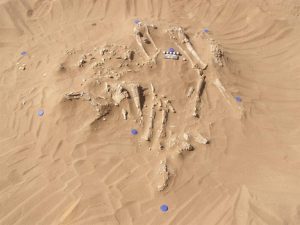Polish archaeologists discovered a unique graveyard in the Affad Basin, northern Sudan, which contains graves of people in the close vicinity of cow and sheep burials. The site is dated to Neolithic about 6000 years ago.

The burial site studied by archaeologists in the Shimaliya province does not contain graves typical for Neolithic period from the area. Few Neolithic graveyards are known from Sudan and usually they contain individuals with poor grave goods, such as ceramic vessels, and only very few selected individuals were offered precious stones or ivory items. The new cemetery site differs significantly from the others.

One of the burials contained a male individual with 10 ivory bracelets and beads made of carnelian and amazonite. The burial chamber contained also three granite slabs used for grinding dye. According to the researchers such items were not known from the area, but were found few hundred kilometres to the North, in the vicinity of Nile’s third cataract. By the grave a pit with skeletons of two young sheep were found. Another grave contained remains of a female individual with a young cow and sheep buried next to it. Another human grave was accompanied by a cow and a calf. What’s intriguing is that the cow was put on her back and the calf was placed on her stomach, with both animals’ legs bent to the centre. Human bones are said to be preserved in a poor condition and it is hard for the researchers to determine their cause of death.

The burials with accompanying animals were known from later times in the area, from about half of the 3rd century BC, but they usually contained one animal. In the graves from Neolithic times animal remains were normally found as material that served for crafting adornments or tools. The individuals buried at the site are believed to have been herdsmen living since 8000 years ago in the transition zone in Africa between the Sahara to the north and the Sudanian Savanna to the south. Gradually, due to climate change these communities moved to the Nile Valley and possibly affected the rise of the ancient Egyptian civilisation.

(after Marta Osypińska & Nauka w Polsce)